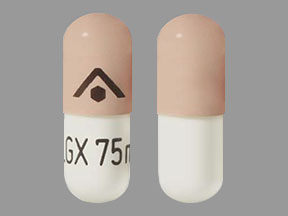Encorafenib Dosage
Medically reviewed by Drugs.com. Last updated on Apr 28, 2025.
Applies to the following strengths: 50 mg; 75 mg
Usual Adult Dose for:
Additional dosage information:
Usual Adult Dose for Non-Small Cell Lung Cancer
450 mg orally once a day in combination with binimetinib
Duration of therapy: Until disease progression or unacceptable toxicity
Comments:
- Prior to initiating therapy, confirm the presence of indicated BRAF mutation in tumor (or plasma, if appropriate) specimens using a US FDA-approved test.
- Refer to the binimetinib manufacturer product information for dosing recommendations.
- If binimetinib is withheld or discontinued, decrease the dose of this drug to 300 mg orally once a day.
Uses:
- In combination with binimetinib, for the treatment of unresectable or metastatic melanoma with a BRAF V600E or V600K mutation
- In combination with binimetinib, for the treatment of metastatic non-small cell lung cancer (NSCLC) with a BRAF V600E mutation
Usual Adult Dose for Melanoma - Metastatic
450 mg orally once a day in combination with binimetinib
Duration of therapy: Until disease progression or unacceptable toxicity
Comments:
- Prior to initiating therapy, confirm the presence of indicated BRAF mutation in tumor (or plasma, if appropriate) specimens using a US FDA-approved test.
- Refer to the binimetinib manufacturer product information for dosing recommendations.
- If binimetinib is withheld or discontinued, decrease the dose of this drug to 300 mg orally once a day.
Uses:
- In combination with binimetinib, for the treatment of unresectable or metastatic melanoma with a BRAF V600E or V600K mutation
- In combination with binimetinib, for the treatment of metastatic non-small cell lung cancer (NSCLC) with a BRAF V600E mutation
Usual Adult Dose for Colorectal Cancer
300 mg orally once a day in combination with cetuximab
Duration of therapy: Until disease progression or unacceptable toxicity
Comments:
- Prior to initiating therapy, confirm the presence of indicated BRAF mutation in tumor specimens using a US FDA-approved test.
- Refer to the cetuximab manufacturer product information for dosing recommendations.
- If cetuximab is discontinued, this drug should also be discontinued.
Use: In combination with cetuximab, for the treatment of metastatic colorectal cancer (CRC) with a BRAF V600E mutation after prior therapy
Renal Dose Adjustments
Mild or moderate renal dysfunction (CrCl 30 to 89 mL/min): No adjustment recommended
Severe renal dysfunction (CrCl less than 30 mL/min): A recommended dose has not been established.
Liver Dose Adjustments
LIVER DYSFUNCTION:
Mild liver dysfunction (Child-Pugh A): No adjustment recommended
Moderate or severe liver dysfunction (Child-Pugh B or C): A recommended dose has not been established.
HEPATOXICITY:
- Grade 2 AST/ALT increased: Maintain the dose; if no improvement within 4 weeks, withhold this drug until improved to grade 0 or 1, or to pretreatment/baseline levels; then, resume at same dose.
- Recurrent grade 2 or first occurrence of any grade 3 AST/ALT increased: Withhold this drug for up to 4 weeks; if improvement to grade 0 or 1, or to pretreatment/baseline level, resume at reduced dose. Permanently discontinue this drug if there is no improvement.
- First occurrence of any grade 4 AST/ALT increased: Permanently discontinue this drug OR withhold therapy for up to 4 weeks. If improvement to grade 0 or 1 or to pretreatment/baseline level, resume at reduced dose; if no improvement, permanently discontinue this drug.
- Recurrent grade 3 AST/ALT increased: Consider permanently discontinuing this drug.
- Recurrent grade 4 AST/ALT increased: Permanently discontinue this drug.
Dose Adjustments
MELANOMA or NSCLC:
Stepwise Dose Reductions for Adverse Reactions:
- First dose reduction: Decrease to 300 mg orally once a day
- Second dose reduction: Decrease to 225 mg orally once a day
- Third dose reduction: Permanently discontinue therapy if unable to tolerate 225 mg orally once a day.
If Therapy with Binimetinib is Withheld: Reduce encorafenib dose to a maximum of 300 mg orally once a day until combination therapy is resumed.
COLORECTAL CANCER:
Stepwise Dose Reductions for Adverse Reactions:
- First dose reduction: Decrease to 225 mg orally once a day
- Second dose reduction: Decrease to 150 mg orally once a day
- Third dose reduction: Permanently discontinue therapy if unable to tolerate 150 mg orally once a day.
If Therapy with Cetuximab is Discontinued: Discontinue treatment with encorafenib.
DOSE MODIFICATIONS FOR SELECTED ADVERSE REACTIONS:
New Primary Malignancies:
- Non-cutaneous RAS mutation-positive malignancies: Permanently discontinue this drug.
- Cutaneous malignancies: Dose modification is not recommended.
Cardiomyopathy:
- Symptomatic congestive heart failure or absolute decrease in left ventricular ejection fraction (LVEF) greater than 20% from baseline and below lower limit of normal (LLN): Reduce by 1 dose level
- If improvement to at least LLN and absolute decrease is 10% or less as compared to baseline, continue at reduced dose
- If no improvement, withhold treatment until improvement to at least LLN and absolute decrease is 10% or less as compared to baseline; then, resume at reduced dose or reduce an additional dosing level.
Uveitis (including Iritis and Iridocyclitis):
- Grade 1 to 3: Withhold this drug for up to 6 weeks if grade 1 or 2 uveitis does not respond to specific ocular therapy, or for grade 3 uveitis. If improved, resume at same or reduced dose; if not, permanently discontinue this drug.
- Grade 4: Permanently discontinue therapy.
QTc Prolongation:
- QTcF greater than 500 milliseconds (ms), with 60 ms or less increase from baseline: Withhold this drug until QTcF is 500 ms or less; then, resume at reduced dose. If more than 1 recurrence, permanently discontinue this drug.
- QTcF greater than 500 ms, with greater than 60 ms increase from baseline: Permanently discontinue this drug.
Dermatologic:
- Grade 2: If no improvement within 2 weeks, withhold this drug until grade 0 or 1; resume at same dose.
- Grade 3: Withhold this drug until grade 0 or 1; resume at same dose if first occurrence or at reduce dose if recurrent.
- Grade 4: Permanently discontinue this drug.
Other Adverse Reactions (Including Hemorrhage and Hand-Foot Skin Reaction):
- Recurrent grade 2 or first occurrence of any grade 3: Withhold this drug for up to 4 weeks; if improvement to grade 0 or 1, or to pretreatment/baseline level, resume at reduced dose. Permanently discontinue this drug if there is no improvement.
- First occurrence of any grade 4: Permanently discontinue this drug OR withhold therapy for up to 4 weeks. If improvement to grade 0 or 1 or to baseline level, resume at reduced dose; if no improvement, permanently discontinue this drug.
- Recurrent grade 3: Consider permanently discontinuing this drug.
- Recurrent grade 4: Permanently discontinue this drug.
COADMINISTRATION WITH STRONG OR MODERATE CYP450 3A4 INHIBITORS:
General Recommendations:
- Avoid concomitant use of strong or moderate CYP450 3A4 inhibitors during therapy; drug exposure is expected to be significantly higher.
- Use clinical judgment with close patient monitoring and dose adjustment (when indicated) if concomitant use cannot be avoided.
- After discontinuing use of CYP450 3A4 inhibitor for 3 to 5 half-lives, resume this drug at the prior dose.
Dose Reductions During Concomitant Use with a Moderate or Strong CYP450 3A4 Inhibitor:
- Current dose 450 mg once a day:
- Moderate inhibitor: Decrease dose to 225 mg once a day
- Strong inhibitor: Decrease dose to 150 mg once a day
- Current dose 300 mg once a day:
- Moderate inhibitor: Decrease dose to 150 mg once a day
- Strong inhibitor: Decrease dose to 75 mg once a day
- Current dose 225 mg once a day:
- Moderate or strong inhibitor: Decrease dose to 75 mg once a day
- Current dose 150 mg once a day:
- Moderate or strong inhibitor: Decrease dose to 75 mg once a day
Comments:
- Dose modification of this drug when administered with binimetinib or with cetuximab is not recommended for ocular events other than uveitis, iritis, and iridocyclitis, interstitial lung disease/pneumonitis, creatine phosphokinase elevation, rhabdomyolysis, and venous thromboembolism.
- Consult the binimetinib or cetuximab manufacturer product information for adverse reaction dose modifications associated with each product, as appropriate.
Precautions
CONTRAINDICATIONS: None
Safety and efficacy have not been established in patients younger than 18 years.
Consult WARNINGS section for additional precautions.
Dialysis
Data not available
Comments:
- This drug is highly bound to plasma proteins; efficient removal via hemodialysis is unlikely.
Other Comments
Administration advice:
- For oral use
- Consult the manufacturer product information prior to treatment for detailed recommendations.
- Before starting therapy, confirm the presence of indicated BRAF mutations in tumor and/or plasma specimens using a US FDA-approved test.
- Administer with or without food.
- If a dose is missed, do not administer an additional dose if it is within 12 hours of the next dose.
- If vomiting occurs after administration, do not administer an additional dose; continue with the next scheduled dose.
Storage requirements:
- Store at 20C to 25C (68F to 77F); excursions permitted between 15C and 30C (59F and 86F).
- Protect from moisture; keep desiccant in bottle and container tightly closed.
General:
- Limitation of use: This drug is not indicated for treatment of patients with wild-type BRAF melanoma, wild-type BRAF CRC, or wild-type BRAF NSCLC.
- Information on US FDA-approved tests for the detection of BRAF mutations is available at: http://www.fda.gov/CompanionDiagnostics
Monitoring:
- Cardiovascular: For left ventricular dysfunction (prior to therapy, after 1 month, and then every 2 to 3 months thereafter); for QT prolongation or for risk thereof (prior to and during therapy as indicated)
- Dermatologic: Skin evaluations (prior to therapy, every 2 months during therapy, and for 6 months after discontinuation)
- Hepatic: Liver function tests (prior to and during therapy as clinically indicated)
- Metabolic: Electrolytes (prior to and during therapy; correct abnormalities as indicated)
- Ocular: Ophthalmic evaluations (at regular intervals during therapy)
- Oncologic: For new non-cutaneous malignancies (prior to, during, and after therapy)
Patient advice:
- Read the US FDA-approved patient labeling (Medication Guide).
- Prior to treatment, ensure confirmation of BRAF V600E or V600K mutation, as indicated.
- Tell your healthcare provider about all of the medicines you take.
- Inform your health care provider immediately for change or development of any new skin lesion.
- Report any symptoms of heart failure, liver dysfunction, unusual bleeding, vision changes, or syncope to your health care provider.
- Patients of childbearing potential: Contact your health care provider regarding a known or suspected pregnancy. Use effective non-hormonal contraception during treatment and for 2 weeks after the last dose.
- Breastfeeding is not recommended during treatment.
Frequently asked questions
More about encorafenib
- Check interactions
- Compare alternatives
- Reviews (1)
- Side effects
- During pregnancy
- Drug class: multikinase inhibitors
- Breastfeeding
- En español
Patient resources
Other brands
Professional resources
Other brands
Related treatment guides
See also:
Further information
Always consult your healthcare provider to ensure the information displayed on this page applies to your personal circumstances.


